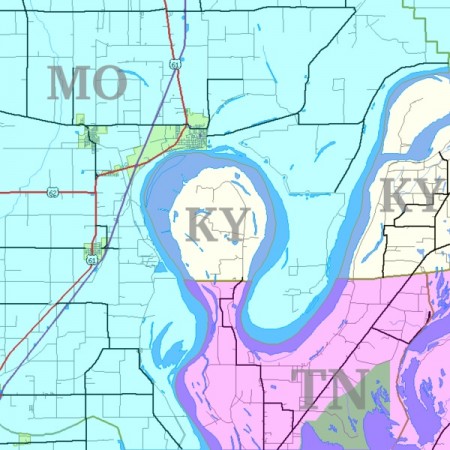heart
I 3D printed Margaret an anotomical heart for Valentine’s day. It came out pretty well.
I actually printed three. I gave her the one on the far right.
I 3D printed Margaret an anotomical heart for Valentine’s day. It came out pretty well.
I actually printed three. I gave her the one on the far right.
My new buddy Jesse Lonergan is a comic book artist. He’s been drawing sketches of one moment each day and I appeared in one from last week after we watched a baseball game together. I’m the one in the hat.
Also worth checking out: his dancing Star Wars drawings and A-Z of crushes. I also just read Joe & Azat, a graphic novel based on his time in Turkmenistan in Peace Corps; I found it entertaining and thoughtful.

From the very interesting Strange Maps post about the Kentucky Bend enclave.
Mark Twain writes in Life on the Mississippi:
Both families belonged to the same church … They lived each side of the line, and the church was at a landing called Compromise. Half the church and half the aisle was in Kentucky, the other half in Tennessee. Sundays you’d see the families drive up, all in their Sunday clothes, men, women, and children, and file up the aisle, and set down, quiet and orderly, one lot on the Tennessee side of the church and the other on the Kentucky side; and the men and boys would lean their guns up against the wall, handy, and then all hands would join in with the prayer and praise; though they say the man next the aisle didn’t kneel down, along with the rest of the family; kind of stood guard.
The other day I started realized that toilet paper is pretty non-linear. (As I’m not the first person to point out.) The last part of the roll disappears a lot quicker than the start because each sheet makes up more and more of a warp around the roll.
I decided to do some calculations and make it real by measuring (using my awesome new Mitutoyo calipers I love) a roll of 350 sheet two-ply toilet paper I have here.
Conceptually one can look at it as a series of concentric shells of radius Rn and length 2*pi*Rn. A roll with no center tube looks like:
L = pi*R^2/T + pi*R
where L is the length of paper, R is the radius, T is the paper thickness.
I’m in Johannesburg now. Jo’burg, Joeys or Jozi.
—

I came up to the high country to go to a couple US America soccer games. I went to the US-Slovenia game on Friday. Even though I had the cheapest class of tickets for the game at Ellis Park, somehow I had great seats. See my view above.
I think America should have won with a botched call from the ref disallowing the would-be winning goal. That said, I really had a good time at the game. The atmosphere and the game were exhilarating.
—

I drove up through the Karoo, the semi-arid interior of the country. It’s a stark and beautiful area. It’s cold at the moment; the snow on the mountains marks the first time I’ve seen it in the country.
It’s a long drive, some fifteen and a half hours over two days. It’s easy to forget that South Africa is this big.
—

I rode the brand new Gautrain yesterday just for fun. I like high speed rail. This never really had a chance to get up to full speed but it was still impressive.
—
Today I watched the Slovakia-Paraguay at a fan park in Newtown (pronounced as if it was two words) and went to the top of the Carlton Centre, the tallest building in Africa (but not tallest structure). The tower used to be prime property but is now in a fairly rundown area; on the other hand, Newtown seems to be in the middle of revitalization.
I set my alarm (on my phone) for 9am on Sunday morning. After it went off, I lazied around bed for a few minutes, checking email and blogs. I looked at the clock on my computer to see it was 10:16am.
Android decided that I had a time change—back an hour, so it was an autumn time change—overnight despite the fact that South Africa doesn’t have time changes.
It was autumn so it knows I’m in the southern hemisphere, but my time zone is set to “South African Standard Time” so it knows I’m in SA. I’m not sure what’s going on.
A friend just forwarded me this email I sent from the day before my 23rd birthday, just as I’m about to leave Boston. It displays my sadness about my favorite MIT dialup[1] server being retired.
(All of the MIT servers were named after hacks. I’ve linked the hacks below.)
From: bischoff@MIT
Subject: sad
Date: August 26, 2003 3:27:31 PM PDT
To: tepd@xyz.orgnerd-xing and cathedral-seven are no more. nerd-xing was my favorite dialup for a long time
18.7.16.67 25 TEST contents-vnder-pressvre 3000 18.7.16.73 25 ATHENA-NORMAL buzzword-bingo 25731 18.7.16.69 25 ATHENA-NORMAL department-of-alchemy 25902 18.7.16.80 25 ATHENA-NORMAL magic-pi-ball 26066 18.7.16.75 25 ATHENA-NORMAL biohazard-cafe 26092 18.7.16.71 25 ATHENA-FTP mass-toolpike 26227 18.7.16.64 25 X no-knife 41390(and mass-toolpike isn’t an express server anymore. it’s ftp!)
Cheers,
Adrian
[1] Of course we didn’t actually dial-up to them, we just used our T1 and sshed in.
Any reasonably class covering manufacturing engineering will talk about Toyota and how they’ve created a process that’s really helped them launch ahead of many other car makers. They’ve long inspired me. This NY Times Magazine profile of Toyota reminded me of that.
Management theorists who study Toyota’s production system tend to say that it is difficult to replicate, insofar as the company’s methods are not simply a series of techniques but a way of thinking about teamwork, products and efficiency. Still, some aspects of the system were clearly visible in San Antonio. In the Tundra plant, there is no real inventory of parts, which is a hallmark of Toyota’s approach. Once a truck chassis begins its run on the factory line, an order goes out to, say, an on-site parts supplier that provides seats for the interior. At Avanzar, an independent company located in a large workroom adjacent to the assembly line, I watched workers build a car seat from scratch. They chose a raw steel frame with springs, put it on their own minifactory assembly line to add padding, then leather, and then they transferred it (via pulley, over a partition wall) to the Tundra assembly line, where it was installed in the truck. If the front seat had not been ordered 85 minutes earlier, it would not exist.
It reminds me of a Forbes profile of Honda I read a couple years ago.
Of all the bizarre subsidiaries that big companies can find themselves with, Harmony Agricultural Products, founded and owned by Honda Motor, is one of the strangest. This small company near Marysville, Ohio produces soybeans for tofu. Soybeans? Honda couldn’t brook the sight of the shipping containers that brought parts from Japan to its nearby auto factories returning empty. So Harmony now ships 33,000 pounds of soybeans to Japan. An inveterate tinkerer, Honda also set up a center nearby to develop better soybean varieties and improve agricultural processes.
Fantastic out-of-the-box thinking!
I returned to the Einstein’s Fish logic puzzle that I got stuck on a couple years ago and solved it.
Oops. I just realized I solved the wrong Coudal puzzle. The original one I got stuck on was Lunch, not Einstein’s Fish. Oops. Give me a few minutes here.
Update: I figured out Lunch as well. It took a lot less time than Einstein’s Fish. (I was also a bit warmed up after Einstein’s Fish.)
Long Street Baths, the pool I use, is open 7am-7pm, which doesn’t leave a lot of time to swim outside of work hours. During work hours it’s gloriously empty, but whenever I’ve tried going before or after, it’s crowded.
Tonight it was packed. Actually, it was so packed that it was interesting. There were enough swimmers that if everyone stopped at the same end of the pool, there wouldn’t be enough space for everyone to stand at the wall. The system depended on at least some people moving. Similarly if everyone was swimming at the same time, there’d be collisions.
I’m sure there are systems or parts of systems like this in real life. Bus garages, perhaps, that don’t have enough spots for all the buses to be parked at once. Or delivery systems (UPS, trucking, etc). Can you think of any others?
Anyway, just something that made me think.
| The Daily Show With Jon Stewart | Mon – Thurs 11p / 10c | |||
| William Kamkwamba | ||||
|
||||
Talk about Afrigadget,
You can buy the book here, William Kamkwamba, who was then about 14, made a windmill to provide power for his family based on a picture in a library book. A pretty good interview with him above.
(Kamkwamba is now in school in Jo’burg.)
Powered by WordPress